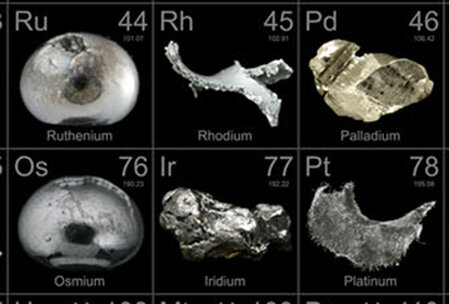We have written many posts about recycling and getting paid for platinum. Today, we would like to explore a related topic – platinum group metals. What are they? And what do you need to know to make money by collecting and recycling them?
The Basics
The platinum group metals are six metallic elements that are grouped together in the periodic table. They are:
-
Platinum – Currently trading for about $1,200
-
Palladium – Currently trading for about $3,000
-
Rhodium – Currently trading for about $24,000
-
Ruthenium – Currently trading for about $255
-
Iridium – Currently trading for about $6,100
-
Osmium – Currently trading for about $400
All these metals are shiny and white in color. But don’t assume that they all behave in the same ways. Platinum, for example, is quite stable – you can leave a platinum ingot just about anywhere and if you come back to it in a year or two, it will not have changed. But osmium, another platinum-family metal, is so volatile that it cannot be stored. That explains why, in most cases, it exists only when it is blended with other platinum-family metals to form an alloy. One that has been making the news lately, and attracting the interest of investors, is platinum-rhodium alloy. Over the last few years, this alloy has been used more and more to make small nozzles that are used to “shoot” molten glass into small fibers that are woven together to make fiberglass sheets. Platinum-rhodium is used in this process because it is stable and able to withstand exposure to high temperatures without deforming.
Where do these metals come from? The largest deposits of them are found in Ontario, in Russia’s Ural Mountains, in South Africa, and in Montana.
Why Do their Prices Vary So Dramatically?
The rarity of these metals contributes to their high value. So does the high demand for them in applications that range from jewelry to medicines and lab testing equipment.
The high prices also help explain why many of these metals are being shaped into bullion bars and sold as investments. Bullion bars are convenient investments – they are small, easy to store, easy to sell when you want to, and verifiable in weight and price.
More Information You Should Know about Platinum Group Metals
-
Platinum is the most common metal in the group, and the only one that is found in pure form in nature, most often in deposits of gold-bearing sands. Platinum is bright, non-corrosive, and malleable.
-
Platinum is the one you are most likely to choose as an investment, because it is found in jewelry, laboratory testing equipment, implanted medical devices, in platinum sponge that is used in industrial processes, and in other items that are far from rare.
-
Palladium is harder than platinum and more scratch-resistant, which explains why small quantities of it are often added to platinum to create an alloy that is used in jewelry.
-
Palladium is also blended with gold to make white gold. That explains why you’re unlikely to find anything made of pure palladium in your search for recyclable precious metals.
-
Rhodium is also found in small concentrations in nature, most often in ores where it is bound to platinum, silver, gold and even palladium. You won’t find too much of it as you search for precious metals to recycle. If you do come across it, chances are that it will be in a platinum/rhodium alloy that is used in jewelry, laboratory crucibles, and sparkplugs that are used in airplane engines.
-
Ruthenium is another rare platinum group precious metal that also occurs as a byproduct when other metal ores are processed. Chances are slim that you will find any of it. If you do, it will probably be in the form of a corrosion-resistant titanium/ruthenium alloy that is used in aerospace applications. Small amounts of ruthenium are sometimes found in platinum jewelry too, where it is added to improve durability and resistance to wear.
-
Iridium is extracted from nickel-bearing ore. Due to its hardness, it is sometimes alloyed with platinum to improve durability. You might find small amounts of it in an alloy of platinum that is used to make laboratory equipment for use in extremely high-temperature settings.
-
Osmium is very rare and found only in trace amounts of nickel ores. Alloys of platinum and osmium are sometimes used in the construction of pacemaker electrodes because they must be highly resistant to corrosion.
So, What Do You Want to Recycle?
If you find a bright, white shiny metal, you should contact Specialty Metals Smelters and Refiners and have us test it for you. Why? Because in order to determine what metal you have, professional testing is required.
Are you looking at pure platinum, or at a rarer alloy of platinum family metals that could be worth much more? Call our highly qualified precious metal recycling consultants at 800-426-2344 to learn more.


